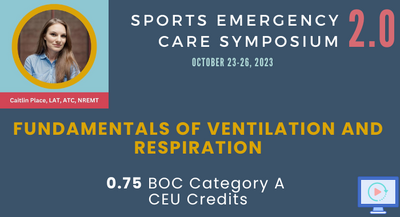General Course Information
Learning Material
Course Info (BOC Domains of Athletic Training; Presentation Description; Learning Objectives; Clinical Practice Gap Statement; Clinical Bottom Line; Summary Conclusions)
BOC Domains of Athletic Training:
- Domain II - Examination, Assessment and Diagnosis
- Domain Ill - Critical Incident Management
- Domain IV - Therapeutic Interventions
Presentation Description:
This presentation delves into the essential concepts of ventilation and respiration in the context of sports emergency care. We'll clarify terminology, explore the anatomy and physiology of the respiratory system, and equip you with the skills to recognize and respond to hypoxia and ventilation issues in both pediatric and adult athletes. Understanding these fundamentals is crucial for ensuring the well-being of athletes in emergency situations.
Learning Objectives:
- Differentiate between common terms used to explain the physiological processes of ventilation and respiration.
- Relate respiratory system anatomy and physiology to ventilation and respiration.
- Recognize progressive assessment findings of hypoxia in pediatrics and adults.
- Identify conditions leading to impaired ventilation and respiration.
Clinical Practice Gap Statement:
There exists a noticeable clinical gap in the proficiency of athletic trainers when it comes to distinguishing between ventilation and respiration in sports-related emergency situations. This shortfall in understanding can result in delayed or inaccurate diagnosis of conditions like hypoxia or compromised ventilation. This gap poses a substantial risk to both pediatric and adult athletes, leading to less effective care when time is of the essence.
Clinical Bottom Line Statement:
A thorough grasp of the intricacies of ventilation and respiration is non-negotiable for delivering optimal sports emergency care. When athletic trainers fill this knowledge void, they are better equipped to implement targeted medical interventions. This acquired expertise contributes to improved clinical outcomes, increasing the safety and well-being of athletes during emergencies.
Summary Conclusion Statements:
- A nuanced understanding of ventilation and respiration is indispensable for athletic trainers who provide emergency care.
- Early detection of hypoxia can significantly impact the quality of care administered to athletes.
- Comprehensive knowledge of the respiratory system's anatomy and physiology is critical for making informed decisions in emergency situations.


